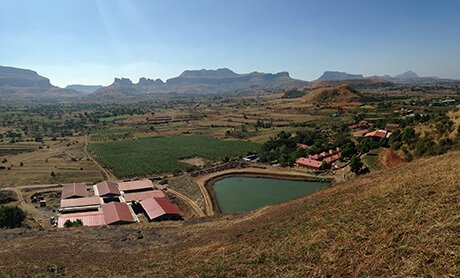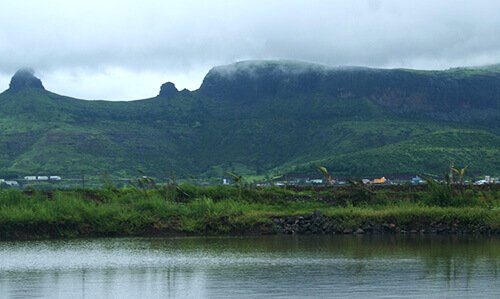Half Spinal Twist pose is one of the best and most important asanas in Hatha Yoga. It has a huge amount of benefits which cover all the body systems.
Full Spinal Twist position was the favourite meditation pose of the Sage Matsyendranath so this pose is named after him. However, as it is a little difficult to practice a simplified form Half Spinal Twist came about.
Taking the asana position
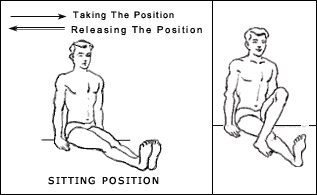
Bend the left leg and place the left foot on the ground over the right knee.
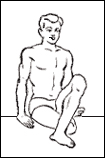
Bend the right leg and fold it so that it is resting on the ground with the right heel near the left buttock.
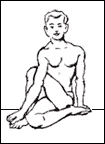
Bring the right hand over the left leg and grab the big toe of the left foot.
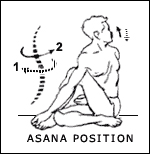
Inhale and exhaling twist the trunk of the body as much as possible, turning the neck so the gaze is over the left shoulder and encircle the waist with the left hand with the palm facing outwards. Continue to maintain the asana, breathing normally.
The asana position
In this position there is a strong twist on the spine and abdomen. The right arm is pressed against the left knee and the left arm is wrapped behind the back, leading to an increased twist on the body. The chest is open and the spine is erect. One side of the abdomen is compressed and the other side is stretched. The right leg and knee remains on the floor. The left knee should be close to the right armpit.
Releasing the asana position
- Inhale and exhaling turn the neck back to face the front.
- Release the hands and place them beside the body.
- Straighten the right leg.
- Straighten the left leg and return to sitting position.
- Practice the same on the opposite side.
Anatomical focus
The spine, hips, abdomen, chest and arms.
Awareness
The twist on the spine, abdomen and relaxed breathing mostly focusing on chest breathing.
Do's
- With the right hand, hold the left big toe from the left of the left knee. If it is difficult to hold the toe then one can hold the ankle or raise the toes keeping the heel on the ground.
- keep the spine vertical, do not bend or drop the shoulder, you can keep the hand on the ground to support the shoulder.
- Encircle the lower back with the left arm, palm facing outwards.
- Turn to the left side in the spine; turn the shoulders and head to the left.
- Try to keep both of the buttocks firmly on the ground.
- Only twist as far as you can and keep your back and neck straight
Don'ts
- Lift either of the buttocks off the ground or sit on the heels.
- Let the back or neck bend forward.
- Overstrain the knees and hips.
- Lift the left sole of the foot from the floor.
Benefits
- Increases the elasticity of the spine, tones the spinal nerves and improves the functioning of the spinal cord.
- Stretches the muscles on one side of the body whilst compressing the muscles on the other side.
- Relieves back pain and stiffness from between the vertebrae.
- Useful for slipped disc.
- Massages the abdominal organs and increases the digestive juices making it useful for loss of appetite and constipation.
- Useful for diabetics, with concentration on the pancreas.
- Regulates the secretion of bile and adrenaline.
- Relieves tension that may have built up in the back from forward and back bending asanas.
- Opens the chest and increases the oxygen supply to the lungs.
- Loosens the hip joints, relieving stiffness.
- Releases tension in the arms, shoulders, upper back and neck.
- Increases purification of the blood as well as the internal organs.
- Improves round shoulders.
Benefits for Women
- Increases the circulation to the pelvic region and therefore providing fresh blood, nutrients and oxygen, improving the health of the reproductive organs as well as the urinary system.
- Useful for preventing urinary tract disorders.
- Beneficial for menstrual disorders.
Therapeutic applications
- Diabetes
- Constipation
- Anorexia
- Cervical Spondylitis
- Urinary tract disorders
- Menstrual disorders
- Indigestion
Precautions and Contra-indications
- Should be avoided during pregnancy and menstruation due to the strong twist in the abdomen.
- People with Heart, abdominal or brain surgeries should not practice this asana.
- Care should be taken for those with peptic ulcer or hernia.
- Those with severe spinal problems should avoid and those with mild slipped disc can benefit but in severe cases it should be avoided.
Duration
To begin with this asana may be held for only a short time but should gradually be built up to 2 minutes. After more practice it can be held for up to 5 minutes on each side.
Additional section
Variations and tips
If it is difficult to hold the foot or remain in the position there are some other variations that can be used to begin with.
- The right leg can be kept straight instead of wrapping it around the body and/or the left foot can be placed a little further away from the body, closer to the right foot.
- Instead of the holding the left foot with the right hand the feet can be raised, closer to the hands.
- Instead of holding the toes the right arm can be bent with the hand pressed against the left shoulder or the left knee can be held by both the arms.
- If it is difficult to balance the left hand can be placed close to the body with the palm on the ground supporting the torso instead of wrapping it behind the back.
If one wants to get more stretch between the shoulder blades then one can wrap the right arm under the left leg and behind the body, clasping the left hand.
If there is discomfort sitting on the floor then one can sit on a pillow.
Preparatory poses
- Leg movements
- Vakrasana Type 1 and 2
Follow up poses
After practicing this pose consistently for some time full Matsyendrasana can be practiced.
Compiled by - Jigyasu Bhaktiratna (Kate Woodworth)




